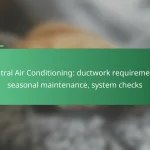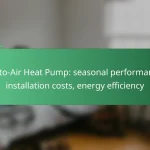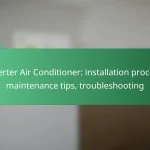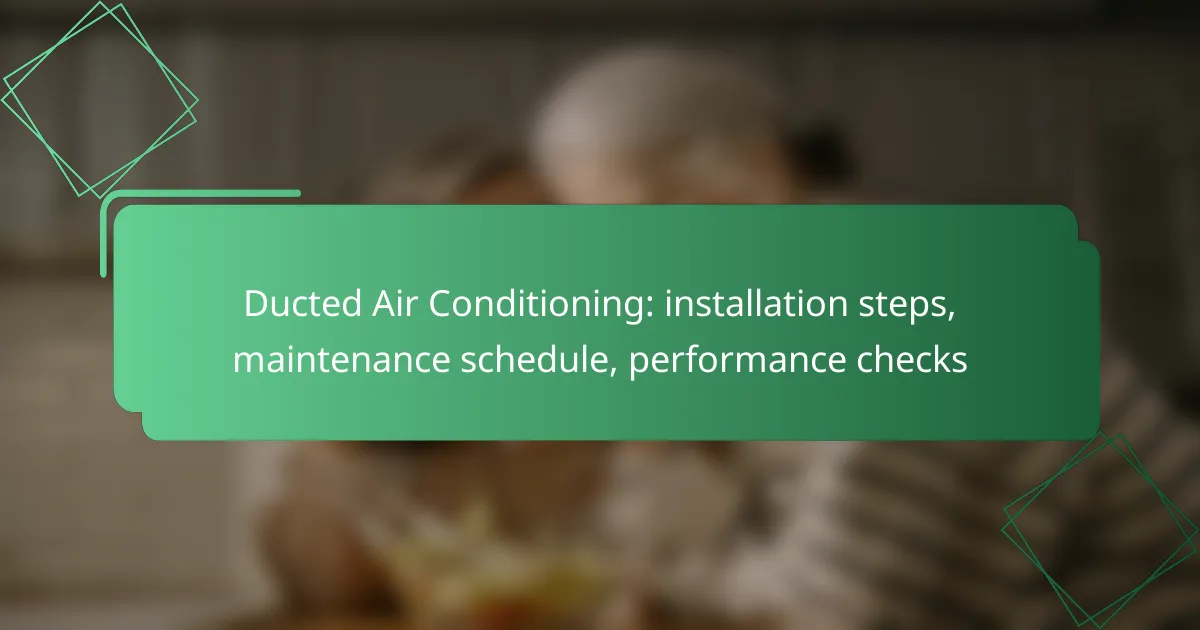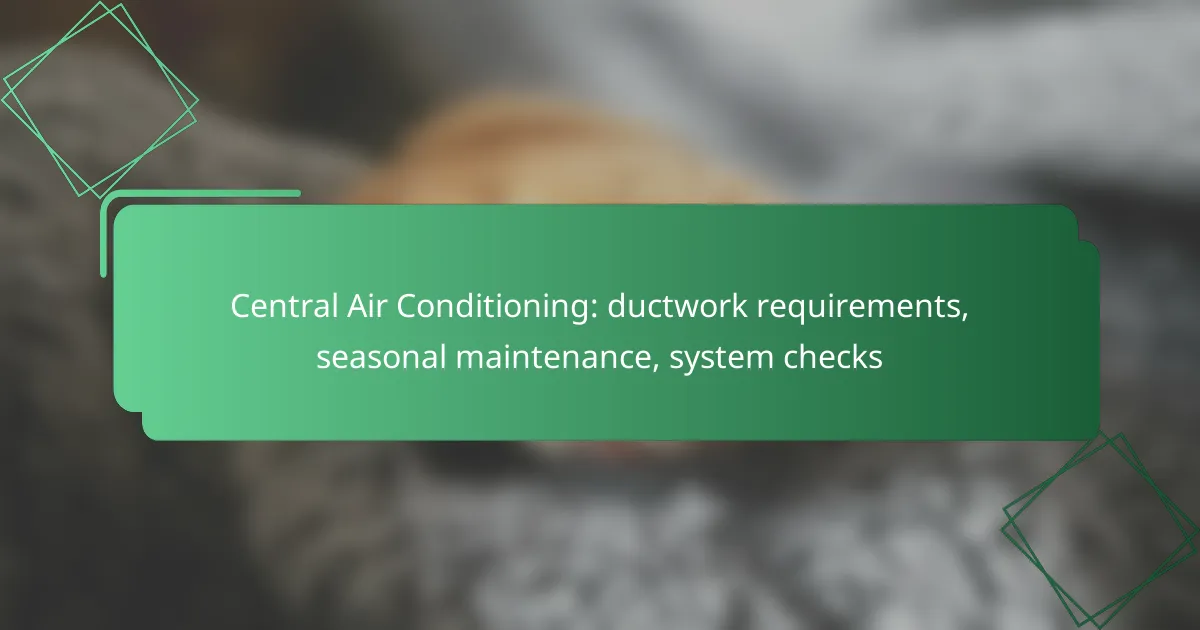Ducted air conditioning systems provide efficient climate control for homes and businesses, but their effectiveness relies on proper installation, regular maintenance, and consistent performance checks. The installation process involves careful planning and testing to ensure the system operates at peak efficiency. To maintain optimal performance, routine tasks such as filter replacement and professional servicing are crucial, along with regular checks of temperature, airflow, and refrigerant levels.

What are the installation steps for ducted air conditioning in the UK?
The installation of ducted air conditioning in the UK involves several key steps to ensure optimal performance and efficiency. Proper planning, installation of ductwork, and thorough testing are essential for a successful setup.
Site assessment and planning
The first step in installing ducted air conditioning is conducting a site assessment to determine the best layout for the system. This includes evaluating the size of the space, existing insulation, and the location of indoor and outdoor units. Planning should also consider the number of ducts needed and their placement for effective airflow.
During this phase, it’s crucial to comply with local building regulations and standards. Consulting with a qualified HVAC professional can help ensure that the system is designed to meet both comfort and efficiency requirements.
Installation of ductwork
Once the planning is complete, the next step is the installation of ductwork. This involves running ducts through ceilings, walls, or floors to connect the indoor unit to the outdoor unit. Proper sealing and insulation of ducts are vital to prevent energy loss and maintain system efficiency.
It’s important to choose the right type of duct material, such as galvanized steel or flexible ducting, based on the specific needs of the installation. Ensuring that ducts are appropriately sized will help maintain optimal airflow and temperature control throughout the space.
Mounting the indoor and outdoor units
After the ductwork is in place, the indoor and outdoor units need to be mounted securely. The indoor unit is typically installed in a ceiling space or a utility room, while the outdoor unit should be placed on a solid surface, away from direct sunlight and obstructions.
Proper mounting is essential to minimize vibrations and noise. Ensure that the units are level and that there is adequate clearance for maintenance and airflow. Following the manufacturer’s guidelines during installation will help avoid common issues.
Electrical connections and testing
The next step involves making the necessary electrical connections for both the indoor and outdoor units. This includes connecting the power supply and ensuring that all wiring complies with UK electrical standards. It’s advisable to hire a qualified electrician for this part of the installation.
After the electrical connections are made, thorough testing should be conducted to ensure that the system is functioning correctly. This includes checking for leaks, verifying airflow, and ensuring that the thermostat is operational.
Final inspection and commissioning
The final step is a comprehensive inspection and commissioning of the ducted air conditioning system. This involves checking all components, ensuring that the system operates efficiently, and making any necessary adjustments. A qualified technician should perform this inspection to confirm that everything meets safety and performance standards.
Once the system is commissioned, the homeowner should receive a detailed explanation of its operation and maintenance requirements. Regular maintenance checks will help prolong the life of the system and maintain its efficiency.

How to maintain ducted air conditioning systems?
Maintaining ducted air conditioning systems involves regular tasks to ensure optimal performance and longevity. Key maintenance steps include replacing filters, scheduling professional servicing, and cleaning ductwork and vents.
Regular filter replacement schedule
Replacing filters in your ducted air conditioning system is crucial for maintaining air quality and efficiency. A typical schedule suggests changing filters every 1 to 3 months, depending on usage and environmental factors like dust and pollen levels.
To keep track, consider marking your calendar or setting reminders. If you have pets or live in a dusty area, you may need to replace filters more frequently to prevent airflow restrictions.
Annual professional servicing
Annual professional servicing is essential for thorough inspections and maintenance of your ducted air conditioning system. Technicians can identify issues that may not be apparent during regular use, such as refrigerant leaks or electrical problems.
During servicing, expect checks on the system’s components, cleaning of internal parts, and performance evaluations. This proactive approach can prevent costly repairs and ensure your system operates efficiently throughout the year.
Cleaning ductwork and vents
Cleaning ductwork and vents is vital for maintaining air quality and system efficiency. Dust, mold, and debris can accumulate in ducts, leading to poor airflow and potential health risks.
It’s advisable to have your ductwork professionally cleaned every 3 to 5 years, or more frequently if you notice significant dust buildup or experience allergy symptoms. Regularly vacuuming vents and ensuring they are unobstructed can also help maintain airflow and system performance.

What performance checks should be conducted?
Regular performance checks for ducted air conditioning systems are essential to ensure optimal efficiency and comfort. Key checks include measuring temperature differentials, assessing airflow, and inspecting refrigerant levels.
Temperature differential measurement
Temperature differential measurement involves comparing the temperature of the air entering and exiting the ducted system. A typical acceptable range is around 16-22 degrees Celsius (30-40 degrees Fahrenheit) between the supply and return air. If the differential is outside this range, it may indicate issues with the system’s efficiency.
To conduct this check, use a reliable digital thermometer. Measure the temperature at the supply vent and the return vent, then calculate the difference. Regular checks can help identify problems early, preventing costly repairs.
Airflow assessment
Assessing airflow is crucial for ensuring that the ducted air conditioning system is distributing air effectively throughout the space. Use an anemometer to measure airflow at various vents, aiming for a consistent flow across all areas. Variations might suggest blockages or duct leaks.
Check for obstructions in ducts and vents, such as furniture or dust buildup, which can impede airflow. Regular cleaning and maintenance can help maintain optimal airflow and system performance.
Refrigerant level inspection
Inspecting refrigerant levels is vital for the efficient operation of ducted air conditioning systems. Low refrigerant levels can lead to inadequate cooling and increased energy consumption. Ideally, refrigerant levels should be checked annually by a qualified technician.
Signs of low refrigerant include ice formation on coils or reduced cooling capacity. If you suspect low levels, do not attempt to refill the refrigerant yourself; contact a licensed HVAC professional to ensure compliance with local regulations and proper handling of refrigerants.

What are the benefits of ducted air conditioning?
Ducted air conditioning offers several advantages, including energy efficiency, consistent temperature control, and quiet operation. These systems are designed to provide whole-home comfort while minimizing energy consumption and noise levels.
Energy efficiency
Ducted air conditioning systems are typically more energy efficient compared to window or split systems. They can cool or heat multiple rooms simultaneously, which reduces the overall energy consumption. Many modern units are rated with high energy efficiency ratings, often exceeding 5 stars.
To maximize energy efficiency, consider installing a programmable thermostat that adjusts temperatures based on your schedule. Regular maintenance, such as cleaning filters and ducts, also plays a crucial role in maintaining efficiency.
Even temperature distribution
One of the key benefits of ducted air conditioning is its ability to distribute air evenly throughout a home. The system uses a network of ducts to deliver conditioned air to each room, preventing hot or cold spots. This results in a more comfortable living environment.
To ensure optimal performance, it’s important to properly size the ductwork and air conditioning unit based on your home’s layout and size. Consulting with a professional can help achieve the best results.
Quiet operation
Ducted air conditioning systems are designed to operate quietly, making them ideal for residential settings. The main unit is usually located outside or in a discreet area, which minimizes noise in living spaces. This is particularly beneficial for bedrooms and other quiet areas of the home.
To further reduce noise, ensure that the ducts are well insulated and that the system is installed correctly. Regular maintenance can also help identify and resolve any issues that may lead to increased noise levels.

What factors influence ducted air conditioning costs in the UK?
The costs of ducted air conditioning systems in the UK are influenced by several key factors, including system size, installation complexity, and energy efficiency ratings. Additional considerations include the brand, the type of controls, and any necessary modifications to existing ductwork.
System Size
The size of the ducted air conditioning system directly affects its cost. Larger systems designed to cool bigger spaces typically come with higher price tags. It’s essential to choose a system that matches the size of your home to ensure efficiency and avoid overspending.
Installation Complexity
Installation complexity can significantly impact the overall cost of ducted air conditioning. If your home requires extensive ductwork modifications or if the installation site is challenging, labor costs will increase. Obtaining multiple quotes from qualified installers can help you find a fair price.
Energy Efficiency Ratings
Energy efficiency ratings, such as SEER (Seasonal Energy Efficiency Ratio) or EER (Energy Efficiency Ratio), play a crucial role in determining costs. Systems with higher efficiency ratings often have a higher upfront cost but can lead to substantial savings on energy bills over time. Investing in a more efficient model can be beneficial in the long run.
Brand and Features
The brand of the ducted air conditioning system can influence its price. Well-known brands may charge a premium, but they often provide better reliability and customer support. Additionally, features such as smart thermostats or advanced filtration systems can add to the cost but may enhance comfort and air quality.
Maintenance and Running Costs
Ongoing maintenance and running costs are essential factors to consider when budgeting for ducted air conditioning. Regular servicing is necessary to keep the system running efficiently, and energy costs will vary based on usage. Setting aside a budget for annual maintenance can help prevent unexpected expenses.

